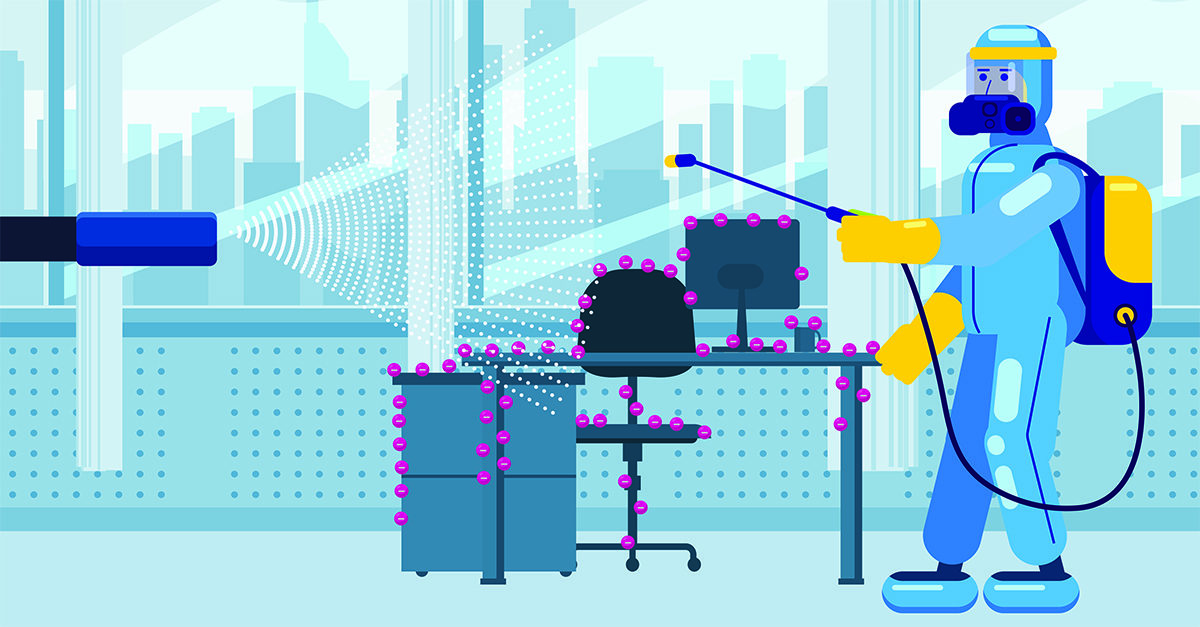What is the biggest misconception about electrostatic technology?
Emily Rosenberg, MPH, Senior Clinical and Scientific Affairs Specialist, CloroxPro
Unfortunately, there are a lot of misconceptions about electrostatic technology. One that we come across most is the idea that with electrostatic sprayers, every surface needs to be disinfected.
This misconception stems from confusing the technology with a fogger or mister device. Misters or foggers deliver disinfectant at small particle sizes (typically average size around 10-30 microns). These small droplets often create a “fog” and hang in the air for a while before being pulled down by gravity. This results in the whole area being covered in disinfectant and is also why you will see higher personal protective equipment (PPE) requirements, instructions for sealing vents and leaving the area during fogging, and longer reentry times.
In contrast, electrostatic sprayers have a more medium-sized particle size (average > 40 microns). This means that the droplets, on average, are outside the inhalable and respirable range (typicallyanything below 30 microns). This is why vents do not need to be sealed and there are generally no or very low reentry times for bystanders when using this technology. Additionally, unlike foggers and misters, the electrostatic particles have an electrical charge making them attracted to the surfaces being sprayed. This results in the particles dropping out of the air quickly and not just waiting for gravity to pull them down. It also allows operators to target high-touch surfaces for disinfection without having to disinfect all surfaces in an area.
Dominic Bazinet, Vice President, Siozen
Dwell time still matters, even when using electrostatic technology. While the technology will enable you to cover much more area with much less liquid, we see claims of immense surface coverage
with a tiny amount of liquid. If you do the math (area/volume of liquid), it literally means that an invisible layer of chemical is applied to the surface. This is not possible in the real world and would not meet even a fraction of the dwell time required (even with fast-acting chemicals).
Josh Robertson, President, EMist
It helps to remember that an electrostatic sprayer is only as effective as the disinfectant being sprayed. Electrostatic sprayers are effective, proven, and
provide a better way to apply disinfectants. When reviewing electrostatic sprayers, we recommend that a user review the sprayer’s flow rate, surface coverage, droplet size (should be > 40 microns), safety (corded vs cordless), electrical charge (+ or -), grounding requirements, place of manufacturing, and price.
What is its biggest strength?
Rosenberg
The biggest strength of electrostatic technology lies in the efficiency of these devices. A study in the Journal of Electrostatics found the more uniform coverage provided by the electrostatically charged droplets allows for better coverage of surfaces compared to application with a noncharged sprayer.
One research team at the Cleveland Clinic and the Cleveland VA investigated utilizing electrostatic spray technology in comparison to a high-level disinfection chamber and UV light. Of the three technologies tested, electrostatic disinfection and the high-level disinfection chamber were the most effective, but the electrostatic device was considered the easiest technology to use as the required spray times for small items were only 20 seconds. In another study, the same researchers found statistically significant reductions in pathogen contamination on portable equipment, wheelchairs, and waiting room surfaces when a disinfectant was applied via an electrostatic sprayer, without any wiping or pre-cleaning. They also found that electrostatic application of the disinfectant was just as effective as manual disinfecting but could be applied four times faster.
Robertson
Portable, cordless electrostatic sprayers can safely, effectively, and quickly apply disinfectants to surfaces of all types in large and small areas in less time, using less labor, for less cost. When spraying big areas, big buildings, or tight spaces, a cordless electrostatic sprayer allows the user to maneuver and move about freely and safely.
Bazinet
The technology pulls all the potential of the chemicals by evenly covering the surfaces in detail with less solution and in a rapid way. It results in more efficient work and increased work quality.
What facilities/surfaces, in your opinion, benefit most from this new cleaning technology?
Robertson
Aviation, government, hospitality, retail, sports, business owners, schools, healthcare, and transportation are of course primary considerations. Electrostatic sprayers are beneficial anywhere people need to quickly and effectively disinfect large surface areas that are frequently touched by many people.
Bazinet
Surfaces and objects with many details that would make it too hard or too long to clean the manual way benefit the most. The technology can also be used to clean soiled surfaces, but only if the sprayer has a nozzle with more flow and more power to leave a thicker layer. Since 100% of the surface is wet in detail, the chemical will work all the surface before the scrubbing action. The soil is then easier to clean, saving a lot of time and effort on the scrubbing. Typically, with the trigger bottle, we wet a few spots on the surface and then spread the chemical and scrub at the same time. A lot of chemical potential is lost.
Rosenberg
Businesses of all sizes, from small family-owned businesses to large athletic stadiums, have adopted electrostatic technology into their disinfecting practices to help ensure their facilities are properly disinfected. Electrostatic sprayers save time and are designed with ergonomics in mind, making surface disinfection more achievable, especially for environmental service workers during long-term use and in facilities pressed for time.
Are there any surfaces/facilities, the technology is not intended for?
Rosenberg
In truth, an electrostatic sprayer is simply an application method (versus trigger sprayer or disinfectant wipe) and there are certainly pros and cons to all application methods. There is no one size fits all. When setting up a protocol, most facilities will use a combination of electrostatic sprayers and manual disinfection wipes or trigger sprayers. In addition, facilities need to consider what type of disinfection is needed where and what is going to have the most cleaning efficiency for their cleaning professionals while also helping to reduce the spread of infectious pathogens in their shared spaces. For example, with electrostatic spraying, often the space needs to be clear of any bystanders during use. For most spaces, this limits their use to the end of the day or when areas are
otherwise unoccupied. When spaces are still occupied, disinfection can be accomplished by using a ready-to-use disinfectant wipe or manual trigger sprayer on high-touch surfaces.
Bazinet
This technology is not well-suited if you only have a small job to do.
What are the newest electrostatic technology features users should look for?
Robertson
Because of the pandemic, there were a lot of flyby- night, get-rich-quick fake sprayers introduced to the world. However, the best electrostatic sprayers are those that are patented, portable, and
lightweight (with a proven track record), that allow the users to apply any EPA-registered disinfectant of their choice and provide a bi-polar (both + and -) electrical charge to the droplets.
Rosenberg
Over the past several years, electrostatic sprayers have become increasingly popular as more and more business have adopted touchless disinfection technologies. Electrostatic technology is now
offered in all shapes and sizes to accommodate all types of usage occasions. Designed with ergonomics in mind, newer handheld electrostatic sprayers are engineered to reduce repetitive
motions needed to spray surfaces. Bending at the waist is less necessary because the user can spray the surface from 2-4 feet away and the repetitive motion of squeezing a trigger is eliminated because the device remains on with a single push. The S-shaped motion that is recommended to spray surfaces also eliminates unnecessary movement at the wrist and shoulders.



